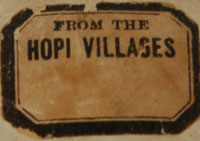Very Small Nampeyo Jar with Whirling Log Design [SOLD]
+ Add to my watchlist Forward to Friend
- Category: Historic
- Origin: Hopi Pueblo, Hopituh Shi-nu-mu
- Medium: clay, pigment
- Size: 2-1/2” height x 5-1/8” diameter
- Item # C3776F SOLD
When Nampeyo of Hano was first making pottery, she was most likely making only utilitarian wares. That is what she had learned from her mother, White Corn - Kochaka, who passed away sometime between 1901 and 1909. Nampeyo’s mother and grandmother were her mentors. It was not until Nampeyo’s husband Lesso was working with the excavation party at the prehistoric Hopi Sikyatki Pueblo ruins, that Nampeyo was introduced to the magnificent prehistoric Sikyatki pottery shards that would influence her life’s work and that of her descendants.
Around circa 1880, Thomas Keam, a trader at Hopi, encouraged Hopi-Tewa potters to make pottery of the Sikyatki style. Nampeyo was one of the potters he encouraged and apparently she was the one destined to become famous for the remainder of her life. In 1905, the Fred Harvey Company opened the Hopi House at the Grand Canyon. It was a three-story pueblo house designed by famous Fred Harvey architect Mary Elizabeth Jane Colter. The intent was to have Hopi families live upstairs during summer months and demonstrate pottery making.
The Hopi House opened on New Year’s day in 1905 and Nampeyo and her family were the first occupants. They stayed through spring of that year then returned to their Hopi home. Again, in 1907, Nampeyo and family moved to the Hopi House at the Grand Canyon for another summer.
 During these summer months, Nampeyo demonstrated making pottery at Hopi House and she sold pieces she made during demonstrations. For logistical reasons, she made smaller items, of a scale that a traveler could easily take home in a carry-on pack or luggage. This small jar is typical of what one would expect that she made at the Grand Canyon. Some of the pottery made there had a paper label attached that specified it was Hopi pottery. Some were labeled From the Hopi Villages, while some even stated Made by Nampeyo. This jar contains one of the "Hopi Villages” labels.
During these summer months, Nampeyo demonstrated making pottery at Hopi House and she sold pieces she made during demonstrations. For logistical reasons, she made smaller items, of a scale that a traveler could easily take home in a carry-on pack or luggage. This small jar is typical of what one would expect that she made at the Grand Canyon. Some of the pottery made there had a paper label attached that specified it was Hopi pottery. Some were labeled From the Hopi Villages, while some even stated Made by Nampeyo. This jar contains one of the "Hopi Villages” labels.
The vessel shape of this small jar is typical Nampeyo style made in larger scale. The designs are Sikyatki style, particularly the abstract bird feathers. The most unusual element is the whirling log* design in the center of the feathers. This is typically a Navajo design from a sandpainting but possibly had a Hopi meaning as well.
Condition: extraordinary condition
Recommended Reading: Canvas of Clay – Seven Centuries of Hopi Ceramic Art by Wade and Cooke
Provenance: from a private collection
*Note about the Whirling Log Symbol: the swastika - or "svastika" from the ancient Sanskrit language - is one of our most universal and positive symbols. Literally it means "auspicious mark," but in various cultures it has signified well-being, highest perfection, happiness, pleasure or good luck.
- Category: Historic
- Origin: Hopi Pueblo, Hopituh Shi-nu-mu
- Medium: clay, pigment
- Size: 2-1/2” height x 5-1/8” diameter
- Item # C3776F SOLD



